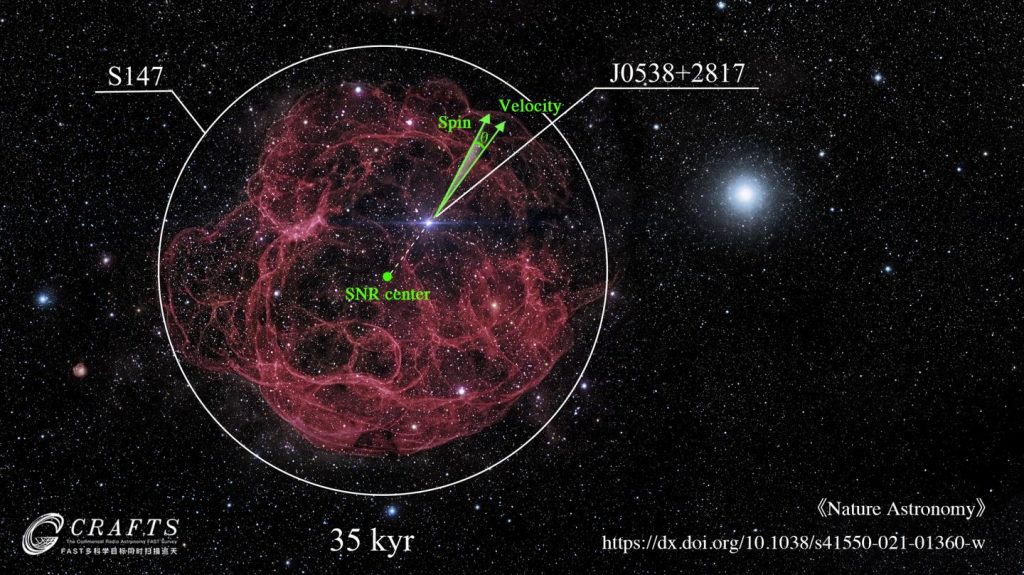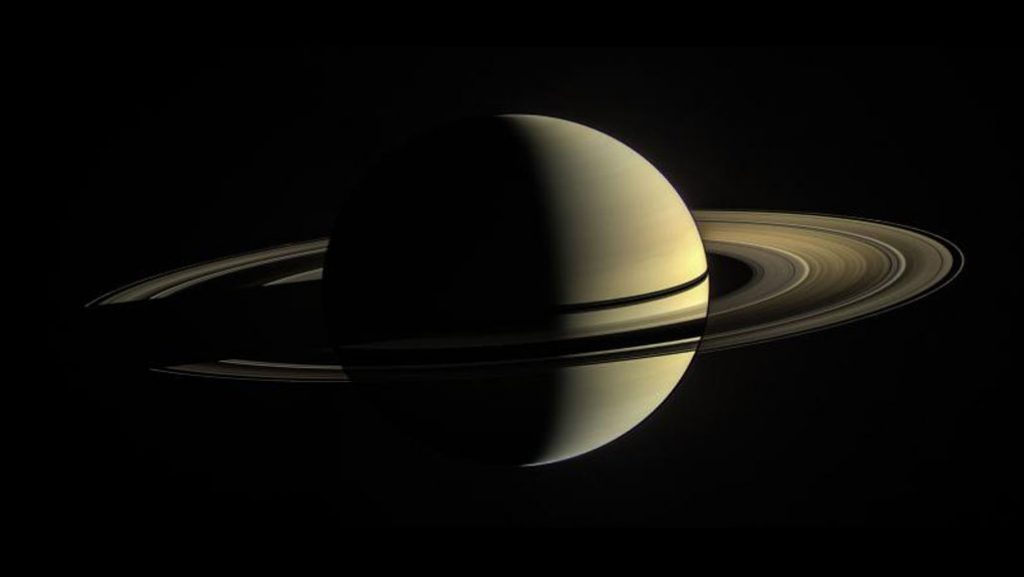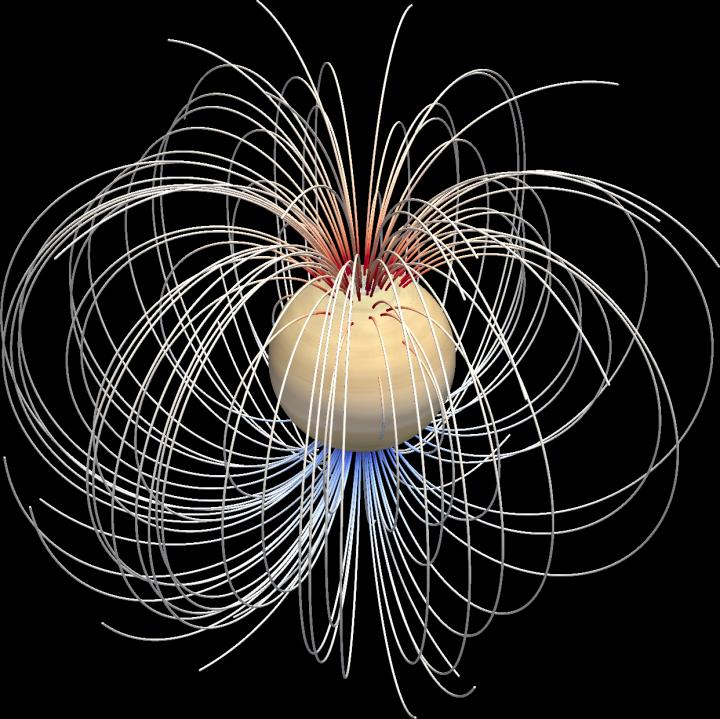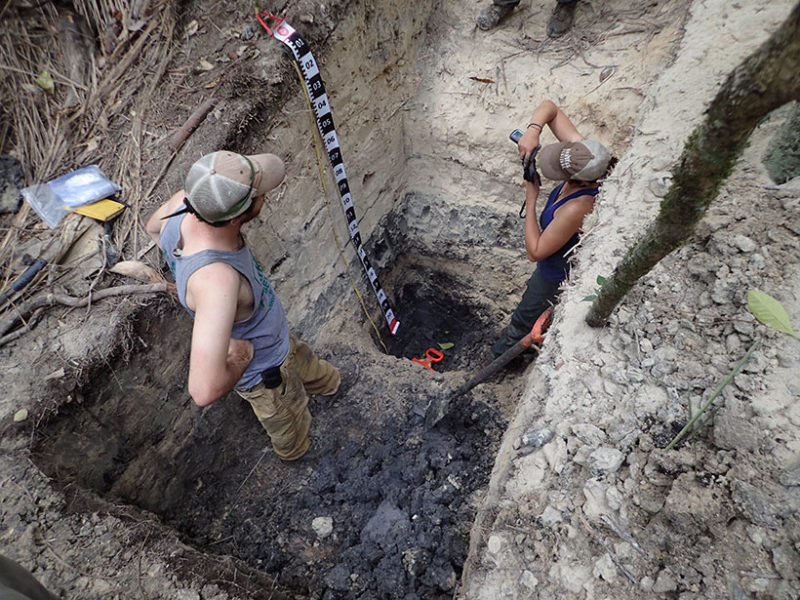Two new studies used data from Cassini’s Grand Finale observations of Saturn and found that the magnetic fields and a wave in the rings provide insight into the core structure and composition of the gas giant. Plus, cosmic rays, how Mayans shaped the Earth, and a review of books by Charles C. Mann.
Media
Transcript
Hello and welcome to the Daily Space. I am your host Dr. Pamela Gay.
And I am your host Beth Johnson.
And we are here to put science in your brain.
As we mentioned yesterday, the current Moon is just the thinnest of crescents, and it won’t rise until just before dawn. If you have the weather and the opportunity to go to a dark location to stargaze, now is your time.

The thing is, no matter how remote a location you may be able to make it to, the sky is never truly dark. This is true at many different levels: human technology generates light that ricochets around in our atmosphere, drowning out the light of the faintest stars and galaxies. Moonlight brightens the sky in the same way as sunlight, just to a significantly lesser degree. Even bright planets like Jupiter can, at their brightest, cast enough light to read by. These are all familiar sources of light. What we forget is our atmosphere actually has its own glow.
In a new paper in The Astronomical Journal, a team led by Miguel R. Alarcón uses low cost, highly sensitive light detectors, called photometers, to measure the changing sky brightness across the minutes and days of the year, across the eleven years that make up our Sun’s solar cycle. During that eleven-year cycle, our Sun goes from a nice quiet star to a magnetically mixed up orb of plasma that periodically launches solar flares and coronal mass ejections across the solar system.
Using their global network of photometers, this team was able to see variations in sky brightness triggered by the influx of solar particles. They were also able to see variations over tens of minutes to hours that were independent of site, season, time, or solar activity. This glow is coming from the upper atmosphere and, like so many other atmospheric effects, is not well understood, yet.
Want to see a truly dark sky? Well, you’re going to need to go to space. Can’t quite afford that ticket? We got your back. The much more affordable and accessible Canary Islands, home of the Roque de Los Muchachos Observatory, is measured to be one of the darkest places on the planet, with only 2% of the sky brightness contributed by human sources.
While we normally think about the sky as it appears to our eyes, the universe doesn’t limit itself to the narrow band of colors visible to humans. If you could see the sky in radio light, you might be able to make out the rapid pulses of fast rotating dead stars.
When some massive stars die, their outer layers explode outward while their inner core collapses down to the diameter of Manhattan island. Like an ice skater drawing their arms inward and inward, these star cores spin ever faster and faster; some rotate as many a thousand times a second. These spinning tops have massive magnetic fields that aren’t aligned with their rotation, and every time the magnetic pole points toward us, radio telescopes see a flash.

The largest radio telescope in the world is China’s Five-hundred-meter Aperture Spherical radio Telescope (FAST), and in a new study of pulsar PSR J0538+2817, a research team led by Jumei Yao has measured not just the pulsar’s rotation but also its three-dimensional motion through space.
This pulsar lurks near the center of supernova remnant S147. We say near because the same supernova that formed that remnant formed the pulsar, and the pulsar has been on the move ever since. While astronomers have previously been able to measure the radial velocity of pulsars – their motion toward and away from us – we haven’t previously been able to measure their 3D motion.
Using FAST and other powerful telescopes around the world, astronomers have now measured how this pulsar moves in the plane of the sky relative to the edges of the supernova remnant, and this has allowed them to see that the direction of the pulsar’s motion and its spin axis, and those two vectors are aligned to a small angle — the difference is just ten degrees. We don’t know if this means pulsar’s spin axis and motion are generally aligned or if just this one pulsar is aligned, but we now know this alignment can be measured, and I expect more publications like this to help us understand this alignment more in the future.
The number of ways supernovae help tell the story of our universe is kind of countless. From producing many of the elements that make up our body to helping us measure the expansion of the universe, they are just there, saying “Hey, study me, I got the info you need.”

One of the more low-key ways they affect us is through the production of cosmic rays. These highly accelerated helium cores and other charged particles can impact planetary atmospheres and mix with the surfaces of atmosphereless worlds to create new molecules. Our own Sun also shoots cosmic rays our way, and the combined efforts of our Sun and the universe beyond darkened the surfaces of icy worlds while lighting the atmosphere. And in a new study in Monthly Notices of the Royal Astronomical Society (MNRAS), researchers led by Donna Rodgers-Lee define how cosmic rays over time may change the chemistry of worlds in ways we need to consider as we define where life may or may not form.
One of the more interesting results of this work is the description of how the Sun’s evolution changes how much of a role external cosmic rays play as compared to solar cosmic rays. Young stars are much more active, and this means their magnetic activity can more effectively push out against the surrounding galaxy and prevent galactic cosmic rays from hitting. At the same time, that active Sun had more cosmic rays of its own to send our way.
How the cosmic rays from the Sun and from the universe beyond impact a planet is also a function of where that planet is in the solar system. If you are an outer world, the galaxy is going to matter more. If you are an inner world, the Sun is going to try and destroy you when it’s young. Want to survive? Stick to the middle. This seems to be generally good advice for life and for building the chemistry of life.
Speaking of middles, scientists are interested in understanding just what the middle of Saturn is composed of and how big it is. And by the middle, we mean “core”.
In a new paper accepted to Nature Astronomy and written by Caltech’s Christopher Mankovich and Jim Fuller, the pair used data taken with the Cassini spacecraft of Saturn’s gravity field to analyze the composition and some of the structure of Saturn’s core. They also examined a wave in Saturn’s C-ring, the closest ring to the planet, because those oscillations can be used to help determine that composition, similar to how we use earthquakes here on Earth to understand the interior of our own planet.

Now, some of you may have this picture in your head of a light fluffy cloud of Saturn with a hard, rocky, metallic core at the center. But it turns out while that core does have about 17 Earth masses of rock and ice, there is also a lot of hydrogen and helium mixed in. The entire core is actually 55 Earth masses, more than half of the total mass of Saturn. This means that the core is not a tight little ball; it’s more like a fluffy ball.
So Saturn, like comedian Gabriel Iglesias, is fluffy.
And this work also helps us understand more about how Saturn formed. The previous theory was that a rocky core formed and began to collect dust and gas. Then the heavier materials sank to the center and formed a compact core like I mentioned above. Afterward, that core continued to attract more hydrogen and helium, which are actually liquid under Saturn’s gravity, until we have the gas giant we have today.
Now, scientists think that the gas and rock and ice all got pulled into one fluffy, extended core, and this new paper provides evidence for that formation theory. Instead of a sudden differentiation between the rocks and ice and the gas, there is a gradual increase in the gas content and decrease in the rock and ice content, which reflects a more gradual development of the core over time. And now we have a much better picture of just how Saturn is structured, at least from an observational standpoint.
While it is awesome to be able to directly observe things like Saturn’s rings to measure the inside structure of Saturn, sometimes, you just can’t measure things the way you’d like, so you have to combine the power of computer models with what observations you have and see what theory allows you to discover.

Another team of Saturn studying researchers used Cassini’s precise measurements of Saturn’s magnetic field to build models of the planet’s interior. It turns out, to get as nice and neat a magnetic field as Saturn happens to have, you have to have a very particular internal structure. Beyond that fluffy core we just discussed, these models, published in AGU Advances by C Yan and S Stanley, take into consideration the near-perfect alignment between Saturn’s rotational axis and magnetic axis – an alignment not seen elsewhere – and study what must be true to see what we see.
According to Stanley: One thing we discovered was how sensitive the model was to very specific things like temperature. And that means we have a really interesting probe of Saturn’s deep interior as far as 20,000 kilometers down. It’s a kind of X-ray vision.
Their results hint at a thick layer of helium rain that influences the planet’s magnetic field, and they also indicate we need another mission to Saturn, this time one that can view Saturn’s Poles, so we can better understand Saturn and all its weird and wonderful beauty.
From the beauty of Saturn, we return to the beauty of Earth, where while we can get up close and personal with our research areas, sometimes we have to use more remote methods to make our observations. In our next story, a team of scientists used lidar observations as well as on-site excavations to examine the Birds of Paradise wetlands in Belize for evidence of just how the Maya survived changing conditions like drought. It turns out that they managed the soil and the water of the region with an extensive system of canals!

The team predominantly used soil analysis to determine just how the agricultural system in the region functioned. They analyzed the sediment in the canals, measuring the ratio of pollen and dating the carbon isotopes found in materials like charcoal and mollusk shells. They found that the Maya began this canal system about 2,100 years ago and used it to distribute water and manage a variety of crops, including squash, maize, avocado, and a variety of other fruits. These crops were grown in blocks surrounded by canals and causeways, and because the water could be distributed throughout the wetland area, the people living there managed to survive droughts.
In fact, the canal system was so extensive by the fifth century CE that the blocks can still be seen today in those lidar scans. Not only that, but the local Mayan population actually outlasted what is known as the Classical Period. The nearby city of Gran Cacao, which likely managed the region in general, collapsed around 900 CE due to drought and political unrest; however, this most recent analysis shows that Mayan society in the Birds of Paradise wetlands continued up until the mid-fourteenth century. At that point, the pollen in the soil begins to revert to the natural forest pollen rather than the crop pollen, indicating that no one was managing the local agriculture any longer.
The canals have long since fallen into disrepair, but their effects on the region remain. There is greater ecological diversity in the Birds of Paradise wetlands than in the surrounding areas that were not managed as heavily by the Maya. They attract larger animals like tapir and deer, and the local descendants continue to harvest the same mollusks and fish that have been feeding people for millennia.
This work was published in the journal Anthropocene, and as lead author Sheryl Luzzadder-Beach notes: These are still lasting hydrological impacts.
Humanity’s actions can outlast the people who made them…
Book Review
As we’ve mentioned before, when the news gives us space, we’re going to work to bring you a review of a space-related book, movie, or other merchandise each week. This week, we’re looking at Charles C. Mann’s book, 1491, which looks at how humans have terraformed our own world, both on purpose and by mistake.

This fast-paced history book looks back to the first mixing of peoples from the old and new world and combines data from traditional archaeology digs and novel satellite techniques to tell a richer story than is told in your standard history book. As a fan of satellite imagery, I delighted in learning how lidar, or laser altimetry, and other remote sensing techniques can be used not just to learn about the earth today, but about the earth in the past, and things that could potentially affect humanity’s ability to terraform other worlds in the future.
One of the oddest things I learned in this book is that earthworms are not native to North America. These earth aerating creepy crawlers had been eradicated during the last glacial period. They weren’t so much purposely re-introduced, as they made their way over in root balls and ships ballast. With the arrival of earthworms, the forests of the northeast suffered a sudden decrease in biodiversity as the earthworms rapidly changed the soil, and removed the thick layers of leaves and debris that once covered the forest floor. This made room for invasive plants and the related invasive bugs and other critters to carve out spaces in the environment, changing North America forever.
This book is filled with these kinds of facts that show how seemingly small changes to a world can change the ecosystem forever. It also shows how these changes are nothing new but have been going on for thousands of years, with fish farming, canals and irrigation, and other aquascaping being evident in South America more than 2,000 years ago. Humans shape our world.
Inspired by this more than 500-page epic reality tale, I am now off to go pour through Google Earth to see the ancient places where now lost civilizations transformed our planet to build thriving cultures that spanned continents. If you are intimidated by the size of this tome, I’d like to assure you that it is written in a way that you can set it down and come back to it over time. It is also available as an audiobook, so if you’re like me, you can learn about how humans have long changed the Earth while you terraform your backyard for that next big garden project.
1491 by Charles Mann is published by Alfred Knopf of New York, is copyright 2005, and has been sitting on my “to review” pile for an embarrassingly long period of time. Go get it now, read about what we knew, and know that here on Daily Space we’ll bring you all the updates as we discover more about our world.
This has been the Daily Space.
Learn More
New Photometry Study Measures Sky’s Natural Brightness
- IAC press release
- “Natural NSB during solar minimum,” M. R. Alarcon, M. Serra-Ricart, S. Lemes-Perera, and M. Mallorquin, to be published in The Astrophysical Journal (preprint on arxiv.org)
FAST Finds Pulsar With Three-Dimensional Spin-Velocity Alignment
- CAS press release
- “Evidence for three-dimensional spin–velocity alignment in a pulsar,” Jumei Yao et al., 2021 May 6, Nature Astronomy
How Cosmic Rays From Different Sources Affect Planets
- Eos article
- “Stellar versus Galactic: the intensity of cosmic rays at the evolving Earth and young exoplanets around Sun-like stars,” D Rodgers-Lee, A M Taylor, A A Vidotto, and T P Downes, 2021 April 5, Monthly Notices of the Royal Astronomical Society
Saturn’s Core is Fuzzy and Magnetic Field is Symmetrical
- ScienceNews article
- “A diffuse core in Saturn revealed by ring seismology,” Christopher Mankovich and Jim Fuller, submitted to ArXiv (preprint)
- Johns Hopkins University press release
- “Recipe for a Saturn‐Like Dynamo,” C. Yan and S. Stanley, 2021 May 5, AGU Advances
The Effects of Mayan Terraforming on Birds of Paradise Wetlands
- Eos article
- “Tropical wetland persistence through the Anthropocene: Multiproxy reconstruction of environmental change in a Maya agroecosystem,” Samantha Krause et al., 2021 March 3, Anthropocene
Credits
Written by Pamela Gay and Beth Johnson
Hosted by Pamela Gay
Audio and Video Editing by Ally Pelphrey
Content Editing by Beth Johnson
Intro and Outro music by Kevin MacLeod, https://incompetech.com/music/


 We record most shows live, on Twitch. Follow us today to get alerts when we go live.
We record most shows live, on Twitch. Follow us today to get alerts when we go live.